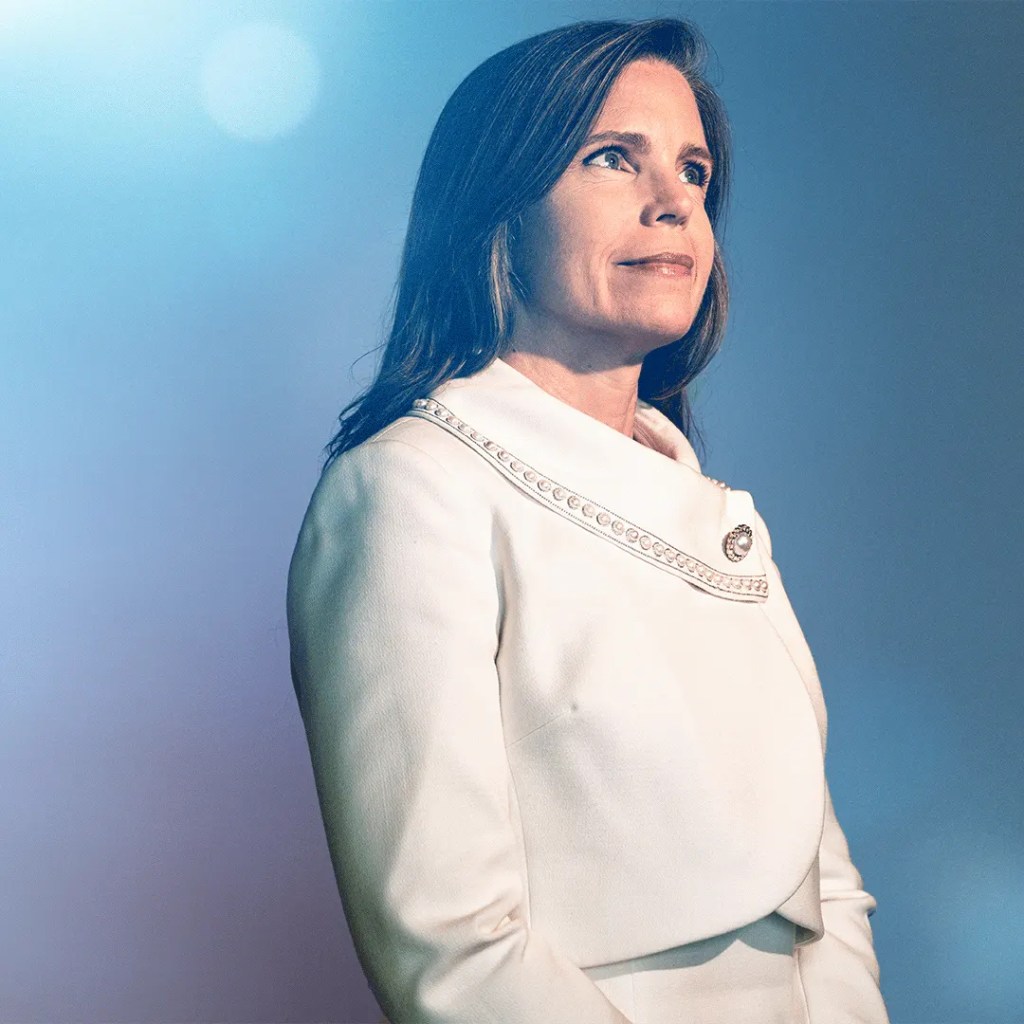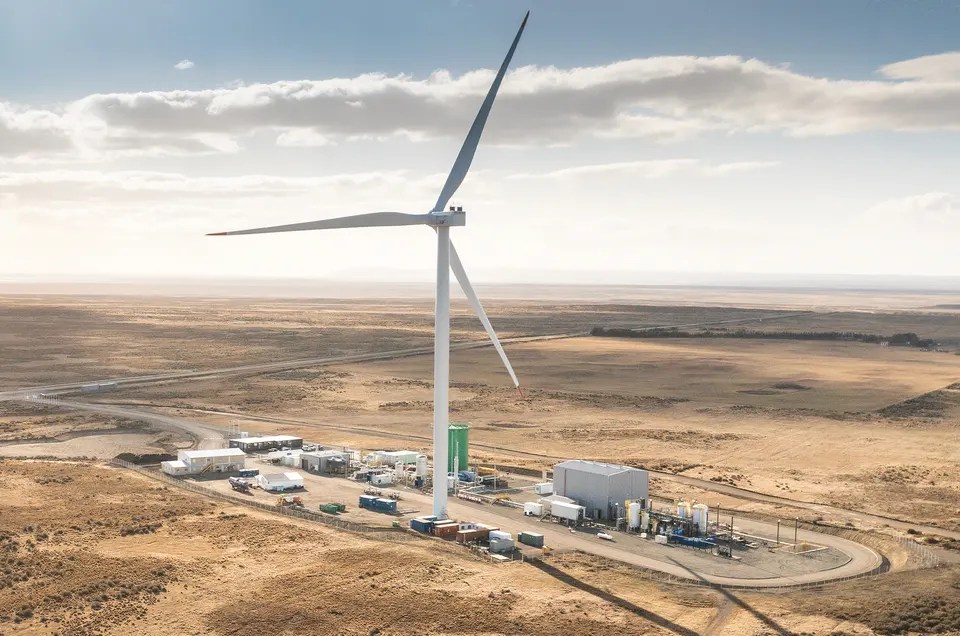Former LNG exec Meg Gentle says it’s serious, and some smart money, including from Porsche and Baker Hughes, agrees with her.

Near the southernmost tip of Chilean Patagonia, on the wind-buffeted Straits of Magellan, the Haru Oni eFuels Pilot Plant sits at the foot of a wind turbine. The plant produces greener gasoline. It starts by taking wind power to run electrolyzer machines, which separate the hydrogen out of water. The hydrogen is then joined with recycled carbon dioxide, in reactions that generate synthetic hydrocarbons — indistinguishable from fossil-derived gasoline.
To be sure, carbon dioxide still comes out the back of any car running off this manufactured fuel, but it’s a start. Porsche AG, an investor, is excited about the prospect of marketing this chemically identical “efuel” (the e is for electricity) to drivers who want both internal combustion and a cleaner climate conscience. It plans to get maximum publicity per gallon, by first using it to gas up its racing teams.
Why build a novel green fuels plant in remote Patagonia? First off, the strong winds created when Antarctica’s cold air meets the warm air from the Pacific. Turbines there can achieve 75% operating efficiency versus an average of 45% for Texas wind farms. Second, the main shareholder of HIF Global, Santiago, Chile-based AME, already develops vast Atacama Desert solar farms, and is looking to erect thousands of wind turbines in Patagonia. That would be enough to make billions of gallons of fuel a year and turn Chile into the unlikely exporter of millions of gallons a year of greener gasoline made from Patagonia winds — the same ones that 500 years ago blew Magellan’s ships through the strait that bears his name.
But Patagonia is not logistically the easiest place to build, which is why HIF aims to construct its first world-scale plant in Texas–near its chemical plants and refineries. Meg Gentle, HIF’s executive director, was captivated by the concept when she heard about it in 2021 from chairman Cesar Norton. Gentle, 48, had just gotten out of the liquefied natural gas business, having served 15 years at pioneering LNG exporter Cheniere Energy followed by four years as CEO of rival LNG developer Tellurian Energy.
Gentle left Tellurian in late 2020, intending to take it easier and run her family investment office, Gemstone Investments, for a while. She agreed to put some money behind HIF (which stands for Highly Innovative Fuels). “I started as an investor. Soon it was ‘Meg can you help us’ with this or that.” Her job for the last two years has been planning and permitting and contracting for a $6 billion plant in Matagorda County, Texas that will make 200 million gallons of greener fuels a year — equivalent to taking the emissions of 400,000 cars off the road.
Gentle feels back in her element. At Cheniere she had raised $40 billion in capital to build a half dozen plants in Texas and Louisiana that now chill and export some 7 billion cubic feet of gas per day — 60% of U.S. LNG exports, and 5% of total domestic supply. She’s not intimidated by cost or complexity. “So many elements of what we are tying together are exactly the same as LNG.”
Bechtel came up with that $6 billion estimate during front-end-engineering. Even if costs go higher, Gentle doesn’t think HIF will have trouble rounding up sufficient capital to get it built. It’s an irony of the green wave — the world needs to make such enormous investments in low carbon infrastructure that megaprojects might be easier to finance than small ones.
“Demand for these projects is boundless,” says Andrew Ellenbogen, managing director at private equity shop EIG, “and will be much better addressed by projects of this size.” EIG, with $24 billion under management, first invested in HIF’s parent company in 2015 to build solar farms and gas-fired generation in Chile.

Ellenbogen has such faith in the potential of efuels “to address hard to abate emissions” that EIG was in even before last year’s passage of the Democrats’ Inflation Reduction Act, with its $500 billion or so in green subsidies, including the potential for developers to generate tax credits on qualified green programs that can reach as high as 60% of capital invested. “The impact of the credits is huge,” says Ellenbogen, but it’s gravy on top. “We would invest with or without them.”
So it makes sense that the HIF project is already a who’s who of big names itching to live up to green promises. Porsche has put $100 million into HIF Global. Baker Hughes, another investor, took part in a $260 million equity infusion in 2022. Addressing the biggest foreseeable bottleneck, Gentle already has hundreds of electrolyzers reserved from Siemens. The Patagonia plant tapped ExxonMobil for its methanol-to-gasoline technology. “Figuring out who are your partners and how you are building those blocks together is probably my most valuable lesson across the entire journey of Cheniere and Tellurian,” says Gentle.
Naturally, there’s an element of betting on the come here. Making a gallon of this fuel requires about 20 pounds of carbon dioxide. Technology to capture carbon dioxide right out of the air started getting headlines five years ago, but is still expensive, at about $250 a ton.
Baker Hughes last year acquired startup Mosaic Materials in order to speed development of its carbon dioxide-trapping metal-organic frameworks– like air filters engineered at the molecular level to grab carbon dioxide out of the air. According to Alessandro Bresciani, a senior vice president at Baker Hughes, the materials “capture CO2 at ambient conditions and require relatively low energy to release the CO2,” making for a lower cost of ownership.
Cool stuff, but Gentle says costs need to get closer to $100 a ton (before generous federal tax credits under the Inflation Reduction Act). So initially, they’ll use other sources of recycled CO2, says CEO Cesar Norton. Baker Hughes declined to share any projection on how many years of iterations it will take to get to that price point.
Gentle and the HIF team picked the site in Matagorda County, Texas for easy access to their most important ingredient: electricity. The plant will have a continuous 24/7 electricity demand of 2,000 megawatts, enough to power about a million homes. Good thing they are located along a high voltage transmission corridor that was overbuilt in anticipation of an unrealized expansion of the South Texas nuclear power plant.
Securing dedicated supplies of renewable electricity is vitally important if projects like this are to actually reduce emissions rather than increase them, says Cy McGeady, an associate fellow at the Center for Strategic and International Studies. At issue is a trifecta of concerns known as “time matching, additionality and deliverability.” In short, you don’t want to run your electrolyzers when the wind stops blowing because then your electricity is more likely coming from fossil fuel generators. And you don’t want to use existing renewable energy projects to power electrolyzers, because then you’re cannibalizing someone else’s low-carbon energy supply. As for deliverability, “You can’t build a wind farm in Nebraska for your plant in Texas,” says McGeady. Right now the Treasury Department is determining what rules developers will have to follow if they want to access the full lineup of tax credits. Stricter rules would add a lot of costs and slow rollout. Which is why McGeady cautions, “economics are wildly speculative until we get guidance from Treasury.”
To make sure HIF’s share of wind power gets put on the grid, Gentle says they will need to buy the output of wind farms with 5,000 megawatts of peak capacity (recall the wind only blows 45% of the time). That will require the dedicated electric output of 1,000 turbines that stand 500 feet tall. All that to make replacement fuel for just 400,000 cars, when the U.S. has 276 million vehicles on the road. Does it make sense to go to all this trouble to extend the internal combustion era? “It’s worth the effort because with the efuel you can operate the existing car fleet on a CO2 neutral base,” says Porsche spokesman Hermann-Josef Stappen.
Gentle (an alum of James Madison University and a Rice University MBA, who earlier worked at Anadarko Petroleum) figures that it will start off costing about $5 a gallon to make efuel–about twice as much as regular gasoline. That’s pricey, though the fuel will fetch a low-carbon premium. How much? A minimum of 30 cents a gallon considering recent California carbon dioxide cap-and-trade prices of about $30 per metric ton (2,200 lbs). In addition to gasoline, HIF plans to sell a large portion of Matagorda’s initial output as shipping fuel, to fleet owners struggling to satisfy stringent new international rules on emissions. Future plants will make jet fuel, she says.
At first when Gentle left the LNG business, amid stalled progress on Tellurian’s Driftwood LNG project, she says she was looking to invest in hydrogen-based fuels, but soon determined the challenges of transporting raw hydrogen would prove overwhelming. For instance, to put natural gas into a tanker ship for export requires chilling it down to -260 degrees into a liquid. “Being in the LNG business, when I learned that in order to move hydrogen on a vessel it has to be even colder, near absolute zero, I immediately knew that that is not going to happen” because the extra costs and difficulty containing such a small molecule would make it impractical. “The boil off is much higher than LNG. As with anything you have to keep un-atmospherically cold, you have to be reliquefying it or you’re losing it.” That drew her to so-called hydrogen carriers, like ammonia (NH3) or synthetics like efuels which are far easier to transport.
While developing the Matagorda site, HIF Global is also working on one in Tasmania, which will source carbon dioxide from the forest products industry. They’ll add more plants in Patagonia as they build out wind turbines, says Norton, who started his career working at a power station in Buenos Aires and over two decades has been a leader in building out natural gas, wind and solar in South America. Norton envisions tens of billions of dollars invested in southern Chile to capture its “strong and constant winds” as the primary raw material for green products. He calls it the “Power-to-X” paradigm.
Gentle envisions hundreds of billions invested in the technology over the coming decades, with HIF Global aiming for a dozen projects that could remove the emissions impact of 5 million cars. Why not? — that much has been invested in North American LNG projects over the past decade. And even a $6 billion plant making the equivalent of 14,000 barrels per day is a drop in the bucket of the 100 million barrels per day worldwide petroleum market (and once complete would be a tasty acquisition for a big oil company).
“This is a solution now, today, already,” she says. “If you’re trying to deploy large amounts of capital you can’t do it $20 million at a time. You have to have scale.”
This story was first published on forbes.com and all figures are in USD.
Forbes Australia issue no.4 is out now. Tap here to secure your copy or become a member here.
Look back on the week that was with hand-picked articles from Australia and around the world. Sign up to the Forbes Australia newsletter here.


